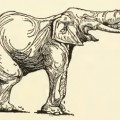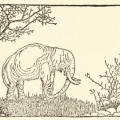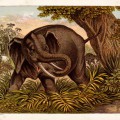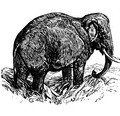Have you ever been eyeball to eyeball with an elephant? I have and it was an awesome experience. But, there just seems to be this sadness deep down in those large brown eyes that speak to me of longing. I might just be fantasizing, but it just seems that these beautiful creatures would much rather be in their native habitat crossing the great plains of Africa and wallowing in great watering holes. But, for me, elephants always seem somewhat sad.
This vintage elephant drawing from 1850, shows a different side of the elephant. I think he looks quite mean and ready to charge. The author of the little book where this elephant image was included mentioned that the elephant was the biggest of all land animals – over five times larger than an ox. He portrays the elephant much like a pet dog. In the wild, he runs from people but once tamed will “take a piece of cake out of your pocket and let you ride upon his back.”
Male African elephants can grow to 13 feet tall and weigh 15,000 pounds. African elephants are the largest living terrestrial animals. Male Asian elephants generally don’t stand more than 9 feet tall and weigh up to 12,000 pounds.
This Book About Animals from 1850 didn’t explain which elephant species that this drawing depicts. In this vintage elephant image, we have an elephant with a raised trunk and his somewhat short tusks would indicate that he might only a youngster. Did you know that with Asian elephants, only the males have tusks? In Sri Lanka, it is common to spot tuskless males as well. But, with the African elephants both the males and females have tusks and they are generally the same size. I admit, I didn’t know that. I guess I always thought just the males had large tusks. Tusks grow throughout the life of the elephant – increasing in length by about seven inches each year.
The copyright information did not make it entirely clear if the author Rufus Merrill illustrated his own work as there was no mention of an illustrator.
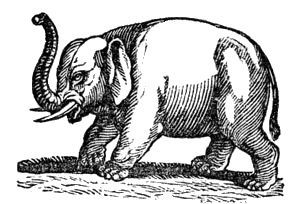
This image is copyright free and in the public domain anywhere that extends copyrights 70 years after death or at least 120 years after publication when the original illustrator is unknown.
